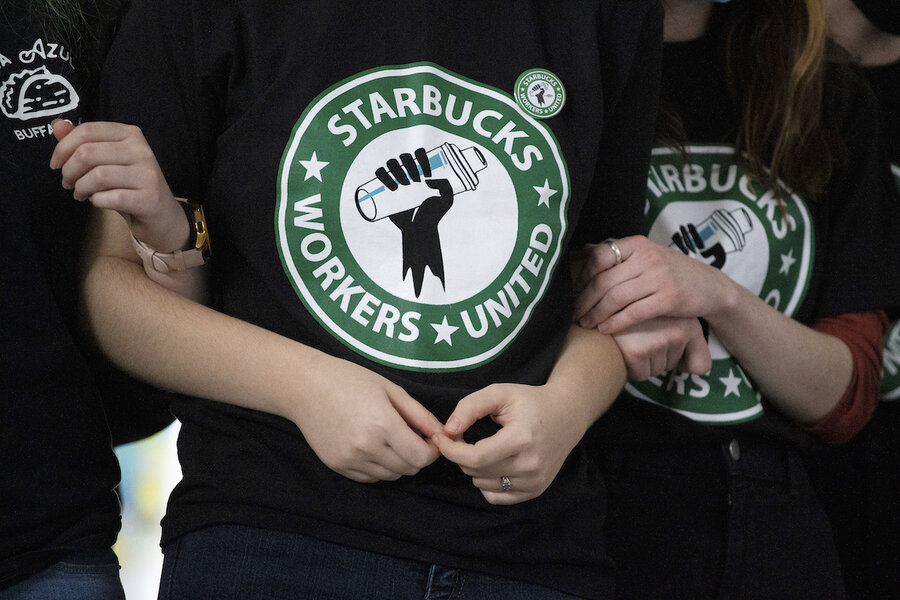Starbucks to face biggest strike on one of its busiest days
Loading...
Thousands of workers at more than 200 United States Starbucks stores plan to walk off the job Nov. 16 in what organizers say is the largest strike yet in the two-year-old effort to unionize the company’s stores.
The Workers United union chose Starbucks’ annual Red Cup Day to stage the walkout since it’s usually one of the busiest days of the year. Starbucks expects to give away thousands of reusable cups Nov. 16 to customers who order holiday drinks.
The union said it was expecting more than 5,000 workers to take part in its “Red Cup Rebellion.” Around 30 stores also staged walkouts Nov 15.
Neha Cremin, a Starbucks barista in Oklahoma City, said she was striking to protest understaffing in stores, especially during promotions like Red Cup Day. Ms. Cremin said workers are already overwhelmed filling delivery orders, drive-thru orders, mobile orders, and in-store orders; promotions add another layer of stress.
“Understaffing hurts workers and also creates an unpleasant experience for customers,” Ms. Cremin said. “Starbucks has made it clear that they won’t listen to workers, so we’re advocating for ourselves by going on strike.”
The Nov. 16 strike was the fifth major labor action by Starbucks workers since a store in Buffalo, New York, became the first to unionize in late 2021. Workers at 110 stores walked out last year on Red Cup Day; most recently, a strike in June protested reports that Starbucks had removed Pride displays from its stores.
But the strikes have had little impact on Starbucks’ sales. For its 2023 fiscal year, which ended Oct. 1, Starbucks reported its revenue rose 12%,to a record $36.0 billion.
Starbucks downplayed any potential impact of the strike Nov. 15, saying it would occur at a “small subset” of the company’s 9,600 company-owned U.S. stores.
“We remain committed to working with all partners, side-by-side, to elevate the everyday, and we hope that Workers United’s priorities will shift to include the shared success of our partners and negotiating contracts for those they represent,” Starbucks said in a statement.
At least 363 company-operated Starbucks stores in 41 states have voted to unionize since late 2021.
Starbucks noted that it has started bargaining with the Teamsters union, which organized a Starbucks store outside of Pittsburgh in June 2022. But the two sides have not reached a labor agreement. The Teamsters didn’t say Nov. 15 whether workers at the unionized store would also be striking.
Relations between Starbucks and Workers United have grown increasingly tense. In October, Starbucks and the union organizing its workers sued each other in a standoff sparked by a social media post over the Israel-Hamas war.
After Starbucks Workers United posted “Solidarity with Palestine!” on X, formerly known as Twitter – two days after Hamas militants rampaged across communities in southern Israel – Starbucks says it received more than 1,000 complaints about the post.
The post was up for about 40 minutes before it was deleted.
Starbucks then sued Workers United for trademark infringement, also saying that the post damaged its reputation. Workers United countered with its own lawsuit, saying Starbucks defamed the union by suggesting it supports terrorism and violence.
Starbucks Workers United has been operating under that name since August 2021, a few months before it unionized its first Starbucks store in Buffalo, New York.
The Starbucks effort was at the leading edge of a period of labor activism that has also seen strikes by Amazon workers, auto workers, and Hollywood writers and actors. At least 457,000 workers have participated in 315 strikes in the U.S. just this year, according to Johnnie Kallas, a Ph.D. candidate and the project director of Cornell University’s Labor Action Tracker.
But Starbucks doesn’t support unionization and has yet to reach a labor agreement with any of the stores that have voted to unionize. The process has been contentious; regional offices with the National Labor Relations Board have issued 111 complaints against Starbucks for unfair labor practices, including refusal to bargain. Starbucks says Workers United is refusing to schedule bargaining sessions.
This story was reported by The Associated Press.







